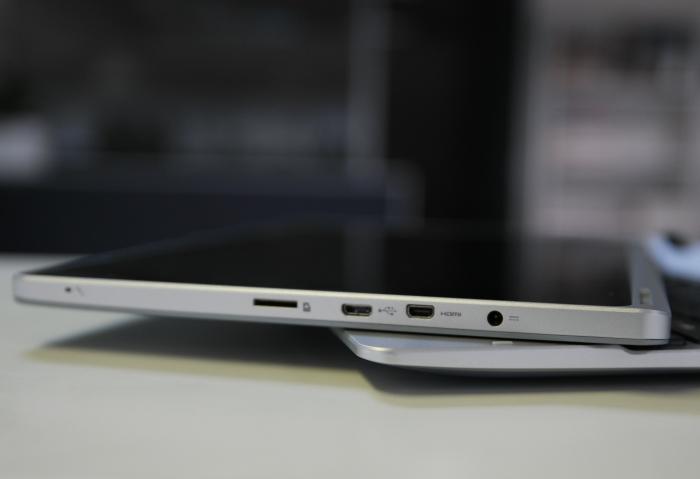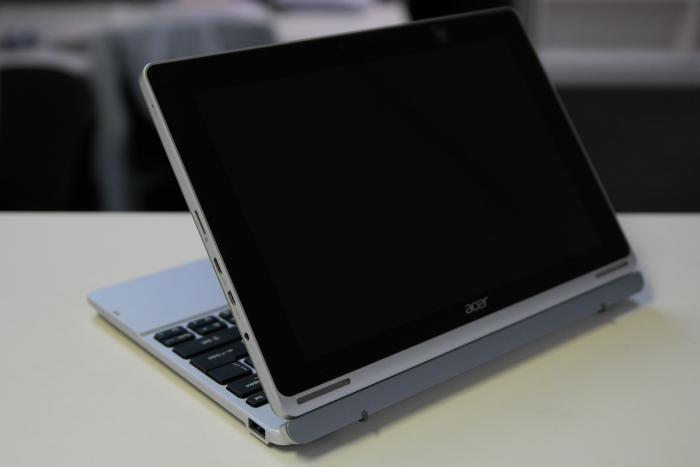
Acer Aspire Switch 10 Pro 2-in-1 notebook PC
It's good as a tablet, but it could use a better keyboard base for use as a notebook
Pros
- Excellent screen
- Tablet has built-in USB and HDMI
- MIcroSD slot
- Front-facing speakers
Cons
- Keyboard doesn't feel great
- Touchpad was 'sticky'
- Too top-heavy
-
Price
$ 749.00 (AUD)
Acer’s Aspire Switch 10 Pro is a hybrid Windows 8.1-based device that’s aimed primarily at the education and business markets. It’s a tablet device first and foremost, but it ships with a keyboard base that allows it to also be used as a notebook or as a display in ‘stand’ or ‘tent’ modes. Processing power is by way of an Intel Atom ‘Bay Trail’ chip, and it powers a 10-inch screen that is one of the best we’ve seen from a tablet in this class.
The 10-inch tablet on its own is easy to handle (560g) and it feels sturdy; there is brushed aluminium on the back and Gorilla Glass on the front. Since it’s based on an Intel Atom Z3735F chip, it’s not an overly quick tablet, but it will suffice for Web browsing, viewing photos, playing videos, and running many Metro UI-based apps from the Windows Store. It also ships with a pen that allows for note taking via Windows’ built-in handwriting recognition.
A 10-inch screen with a 1200p resolution
Acer has done well with the screen on this tablet. It has installed an IPS (in-plane switching) panel that has a native resolution of 1920x1200 pixels. It’s rare to see that resolution these days, on any device let alone an entry-level tablet such as this one (HP’s Pro Tablet 610 G1 also has the same resolution), and it gives a little bit more vertical space than usual for document and Web browser windows. Colours are rich, the output is bright enough to neutralise most reflections from room lights, and the angles are wide so that you can see the screen perfectly regardless of the orientation that you use.
By the same token, having such a high resolution on a Windows tablet can make the screen hard to navigate when the native resolution is actually implemented, unless you use the pen, which can provide more precision when tapping and selecting things in the Windows desktop environment. By default, Acer ships the product with its icons and text set to a big size (Larger) in order to make things easier to tap on, but this means that certain dialogue boxes and menus look muddy due to the scaling (some even retain their small size), and the screen real estate is reduced.
Some issues remain when you use a Windows 8.1-based tablet, mainly with the way touch input works on the desktop. Using a desktop-based Web browser can be difficult since the on-screen keyboard does not pop up automatically when you click on the URL bar or any other text box. It’s a better experience to just use the Internet Explorer browser in the Modern UI, in which the on-screen keyboard does pop up whenever it detects that you are trying to type something.
Along the edges, the tablet has a useful array of features that include a microSD card slot, a micro-HDMI port, a micro-USB port, and a headset port. Acer ships a micro-USB to full-sized USB dongle so that USB sticks and other devices can be plugged in directly when needed. Buttons include power and volume, and there is also a button for invoking the Windows Home screen. This is instead of a capacitive button that’s usually present on such devices, and it’s a good idea since the capacitive button would most likely get in the way when holding the tablet in portrait orientation.


Internal storage is handled by a 64GB solid state drive, which has a formatted capacity of 51GB, and our test model showed about 39GB free for our own usage. In the CrystalDiskMark test that we run, the drive’s sequential read speed was 170 megabytes per second (MBps), while the write speed was 35MBps. That read speed is good, but the write speed is sluggish.
Read more: HP Envy X2 Notebook PC
As for overall performance, the quad-core Intel Atom chip and the 64GB SSD are joined by 2GB of DDR3L memory to provide a user experience that we’ll class as ample. It offers enough speed for browsing most Web sites, though sites that have heavy elements such as Flash, could see the tablet slowing down to a crawl while the processor works hard to show those elements.
In our Blender 3D rendering test, which gauges processing power, our workload took 2min 33sec to complete, which is about the same as what HP’s dual-core, Celeron-based Stream 11 laptop recorded in the same test. It’s not as fast as other ‘Bay Trail’ Atom devices we’ve seen, such as the original Toshiba Encore and the Lenovo ThinkPad 10.
Video performance was fine during our tests. Locally stored 1080p video files played back without any issues, and we were even able to use premium video streaming services such as NBA League Pass. That said, the frame rate of the latter, which is a service that shows American basketball games, was a little on the low side, and sometimes the action was jumpy. For things like YouTube, the performance was smooth.
Networking is supplied by a Broadcom module that supports 802.11a/b/g/n dual-band Wi-Fi, and you also get Bluetooth 4.0. Other things to note are that it has a single camera on the front, as well as front-firing stereo speakers.
Read more: HP Stream 11 laptop
We used the playback of video to gauge battery life. Looping a Full HD, MP4 file while Wi-Fi was enabled and the screen was set to maximum brightness, resulted in a time of 5hr 16min. It’s not a great time, and that can be mainly attributed to the high resolution of the screen.
The keyboard base
The tablet is only one part of the Switch 10. You also get a keyboard base with it that can be attached to the tablet through two slots and the use of strong inbuilt magnets. The tablet can sit in the keyboard dock in a conventional way, or it can sit facing out in order to act as a stand when you want to watch video without holding the tablet (and without the keyboard in the way).

It’s a basic keyboard base though, giving you the option to do some typing and to plug in one device via its single USB 2.0 port. You don’t get any extra features, such as a second battery, or any other video or networking ports.
Because of the 10-inch form factor of the tablet, typing on this keyboard can make for a cramped experience. For the education sector, this might not be a problem, but some business users might get frustrated.
The keys aren’t all that great. They feel resistive and squishy, and don’t quite have the crispness that’s conducive to providing a comfortable long-session typing experience. The arrow keys are half-sized and surrounded by the Page Up and Page Down keys, and the F-keys are set to be used as F-number keys as their primary function, rather than being set to change brightness and volume.
We’re also not fans of the touchpad. The cursor moved around the screen in a fashion that was quite sticky, often stopping before the mark we intended, or jumping over it when we lifted our finger off the pad.
The other thing to note is that the keyboard base doesn’t provide a good counterbalance to the tablet screen. The tablet is heavier, and this causes the unit to lean back too easily on its own. If you use the Switch 10 Pro on your lap, it can fall. It’s best used on a desk and with the screen not tilted too far back. We’ll also note that the rubber feet on the base didn’t provide adequate traction when we used the Switch 10 on our office desk, with the product sliding around easily.
We found the keyboard base to be best for allowing the tablet to be used as a display. With the ability to seat it facing outward in ‘stand’ mode or ‘tent’ mode (tent mode is good for saving desk space), you can rest the tablet on a desk easily to watch videos or to interact with the screen. The magnets that hold the tablet quite strong, and if you don’t line the slots on the tablet up with the base correctly, the magnets will still grip the base, but they won’t support the weight. Separating the tablet from the base requires a firm determination while pulling the tablet up and holding down the base.

What’s the verdict?
The simple notch and magnet design for holding the tablet to the base is a good one, though we can’t help but feel as though there should be more to this product. As a notebook, it leaves you wanting a better typing and touchpad experience, and it can be frustrating when the device leans back on its own due to the weight of the tablet.
As a tablet, though, the Aspire Switch 10 Pro provides a better experience because it’s so light and its screen is so crisp and vibrant. The supplied pen gives you an adequate way to take handwritten notes, and if you use the right apps and stay away from the desktop, the overall touch experience can be a good one.
In short, it’s good if your primary need is a Windows-based tablet with a high-resolution screen, and if you’ll only be using its keyboard base sparingly, rather than for long typing sessions.
An Aspire Switch 10 with a 1366x768-pixel screen resolution is also available.
Brand Post

Most Popular Reviews
- 1 Dell U3223QE review: A winning debut for an IPS Black monitor
- 2 HP Spectre x360 16 review: The right 2-in-1 at the wrong time
- 3 Acer K242HYL review: An affordable monitor for any occasion
- 4 GeForce Now review: You bring the games, Nvidia streams the hardware
- 5 Asus ProArt PA279CV monitor review: The go-to for content creators on a budget
Latest News Articles
- Want to go watch the WWDC keynote at Apple Park? Here’s how to apply
- Apple to support ‘passwordless’ iPhone logins on Android phones and PCs
- If you downloaded iOS 9 on an iPhone 4s, you may be entitled to a refund check
- Best wireless headphones
- An intrepid YouTuber made his own 5K Studio Display for just US$600
Resources
Macworld
What's new, plus best mac-related tips
and tricks

Business Centre
The latest business news, reviews, features and whitepapers

Videos
Watch our video news and reviews from around the world

Guides
Comprehensive buying guides, features, and step-by-step articles

PCW Evaluation Team
Pedro Peixoto
Aruba Instant On AP11D

Set up is effortless.
Cate Bacon
Aruba Instant On AP11D

The strength of the Aruba Instant On AP11D is that the design and feature set support the modern, flexible, and mobile way of working.
Dr Prabigya Shiwakoti
Aruba Instant On AP11D

Aruba backs the AP11D up with a two-year warranty and 24/7 phone support.
Tom Pope
Dynabook Portégé X30L-G

Ultimately this laptop has achieved everything I would hope for in a laptop for work, while fitting that into a form factor and weight that is remarkable.
Tom Sellers
MSI P65

This smart laptop was enjoyable to use and great to work on – creating content was super simple.
Lolita Wang
MSI GT76

It really doesn’t get more “gaming laptop” than this.
Featured Content
- Which Lenovo Laptop Should I Buy?
- Every TV in Samsung's 2022 line-up: OLED, Neo QLED and more!
- Top 10 best Android and Apple phones for under $600
- Everything you need to know about Smart TVs
- What's the difference between an Intel Core i3, i5 and i7?
- Laser vs. inkjet printers: which is better?










